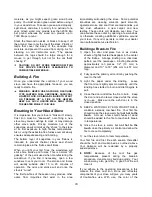
14
Connecting Your Wood Stove
You can install your Mansfield to a prefabricated
metal chimney or a masonry chimney.
Connecting to a Prefabricated Metal
Chimney
When connecting the Mansfield to a prefabricated
metal chimney, you must follow, precisely, the
manufacturer's installation instructions. Use only
Type HT (2100 deg. F), prefabricated metal
chimneys listed per UL 103 or ULC S629 standards.
WARNING: DO NOT CONNECT THE STOVE
TO A CHIMNEY FLUE SERVING ANOTHER
APPLIANCE.
En
sure the size of the chimney’s flue is appropriate
for the Mansfield. The Mansfield requires a 6” (152
mm) inside diameter flue for new installations. A 6”
diameter
flue
provides
adequate
draft
and
performance. You c
an use an 8” (203 mm) diameter
existing flue with a reducer. An oversized flue
contributes to creosote accumulation. (In this case,
bigger is NOT better.)
When purchasing a prefabricated chimney to install
with your stove, be sure to also purchase from the
same manufacturer the wall pass-through (or ceiling
support package), "T" section package, fire-stops
(when needed), insulation shield, roof flashing,
chimney cap, and any other needed accessories.
Follow the manufacturer’s instructions when
installing the chimney and accessories. In addition,
be
sure
to
maintain
all
manufacturer’s
recommendations for the proper clearances to the
chimney.
There are basically two ways to install a
prefabricated metal chimney:
1. An
interior
installation where the chimney
passes inside the residence through the ceiling
and roof.
2. An
exterior
installation where the chimney
passes through the wall behind the stove then
up the outside of the residence.
Whenever possible, choose an interior chimney. An
interior chimney heats up more quickly and retains
its heat; thus promotes a better draft and
discourages the formation of creosote. An exterior
chimney does not benefit from the warmth of being
surrounded by the
building, so it typically operates at
lower flue temperatures than an interior chimney.
An exterior chimney’s draft is not as strong and may
experience increased creosote accumulation.
Figure 10
Figure 11
Содержание 8012
Страница 2: ...2 Intentionally Blank ...
Страница 12: ...12 Figure 9 ...
Страница 16: ...16 Figure 13 ...
Страница 28: ...28 Safety Label ...





























